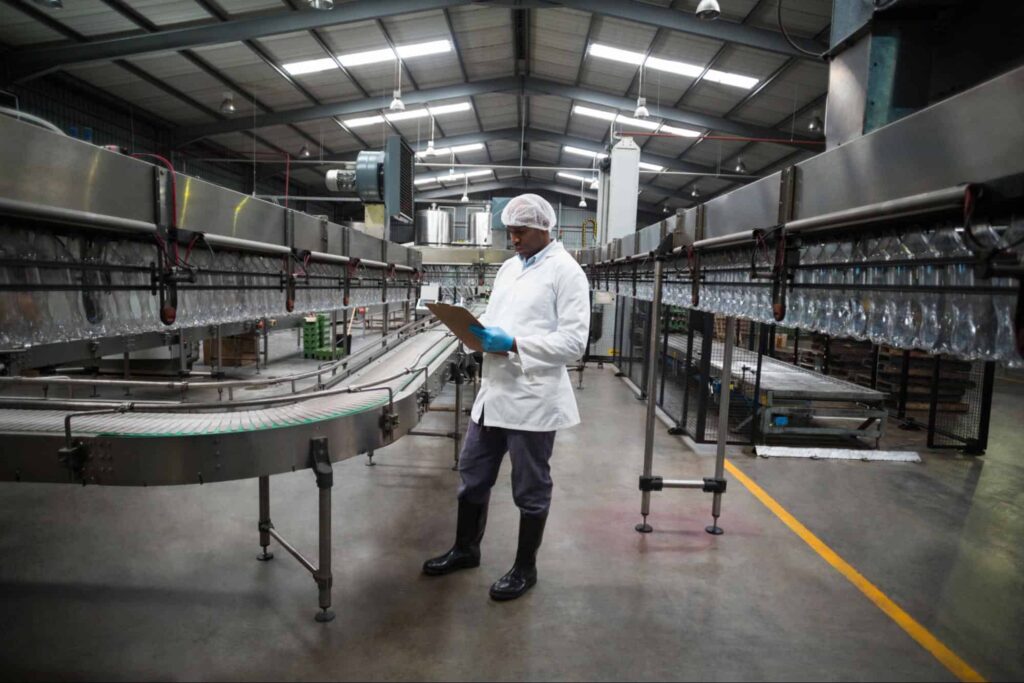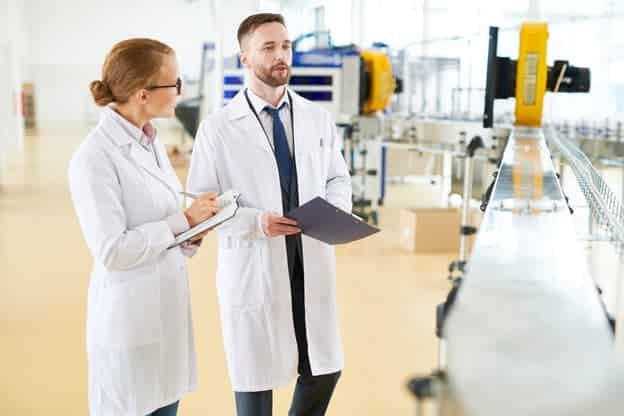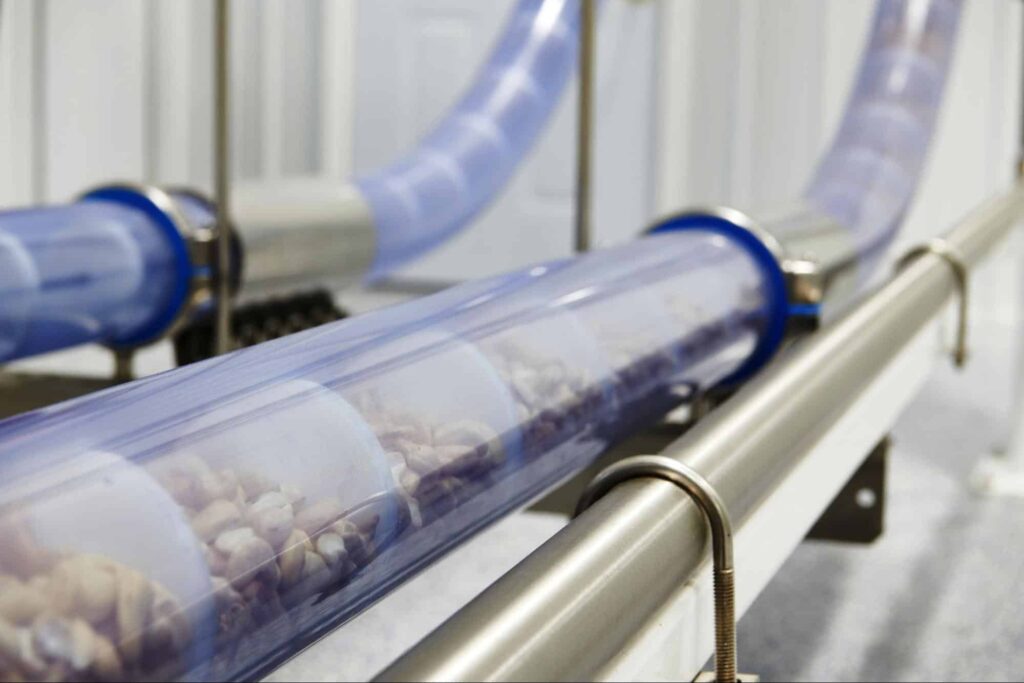Choosing between different food conveyors for your facility can be incredibly difficult. The potential for foodborne illnesses, the need to comply with food safety regulations and guidelines, and the fast-paced nature of the food processing environment all add to the pressure of making the right decision. If you need assistance, Cablevey is here to guide you through the world of food conveying and help you choose the type of conveyor that will best suit your facility’s specific needs and requirements.
What Are Food Conveyors?
A food conveyor is a mechanical system designed to transport food products efficiently along a production or packaging line. These systems vary widely in design based on the specific needs of the industry, such as in bakeries, breweries, or produce packing facilities. They may include belt conveyors with a belt conveyor system, bucket conveyors, and pneumatic conveyor systems.
They must meet stringent hygiene and safety standards, as they directly influence food safety. They are often made of materials like stainless steel for easy cleaning and to withstand various temperatures and conditions. Depending on the process, these conveyors may also be equipped with features for sorting, grading, cooling, or heating the products they handle. These systems are critical to modern food production, enabling high-volume, consistent production and packaging.

Sanitary Requirements of Food Conveyors
Maintaining sanitary conditions in food processing facilities is of paramount importance for ensuring food safety and quality. Not only do consumers expect their food to be free of harmful pathogens, but foodborne illnesses can also have severe consequences for both consumers and the facility.
In the United States, every year, around 48 million people get sick as a result of a foodborne illness. An astounding 128,000 people end up hospitalized! In order to prevent such outbreaks, food processing facilities must adhere to strict guidelines and regulations set forth by government agencies such as the U.S. Food and Drug Administration (FDA) and the United States Department of Agriculture (USDA).

Sanitary Conveyor Design
Maintaining clean and hygienic conditions throughout the food production process is crucial for food safety and quality. One pivotal element in this process is the design and maintenance of food conveyors. These conveyors must be designed with sanitation in mind, considering various factors such as material choice, structural design, lubrication, and sealing. Key considerations for sanitary conveyor design include:
- Smooth surfaces to minimize the accumulation of debris and bacteria. This can be achieved by using materials such as stainless steel or high-density polyethylene (HDPE), which are non-porous and easy to clean. Additionally, conveyors with rounded edges and no sharp corners can help prevent bacteria from accumulating in hard-to-reach areas.
- Easy-to-clean materials and minimized crevices and seams. Materials such as stainless steel or HDPE can help minimize the number of crevices and seams on a conveyor, reducing the number of bacteria that can accumulate on the surface of the conveyor. Additionally, conveyors with removable parts and quick-disconnect fittings can make cleaning and maintenance easier and more efficient.
- Food-grade lubricants to prevent contamination. When designing a food conveyor, it’s important to use lubricants that are safe for use in food processing facilities. Food-grade lubricants are specifically formulated to be safe for use in food-processing environments and can help prevent contamination of these products.
- Proper sealing and guardrails to prevent debris or food particles from falling into the conveyor’s inner workings. These also ensure that any areas that are not visible or difficult to access are sealed off.
Staying abreast of advancements in conveyor technology and regulatory standards can also contribute to more efficient and safe food production, ultimately benefiting both the industry and consumers.
Regular Cleaning and Maintenance
Maintaining hygienic conditions requires not only the initial design and installation of food conveyors but also their regular cleaning and maintenance. This involves conducting frequent inspections to identify potential problem areas that may need repair. It also requires setting up and following scheduled cleaning routines to get rid of any accumulated debris or bacteria, including comprehensive cleaning of the conveyor’s surface and particularly of crevices and seams where food particles might gather.
To keep the conveyor free of harmful bacteria, proper sanitation using food-grade cleaning and sanitizing solutions is crucial, always adhering to the specified usage instructions. Lubrication of moving parts using food-grade lubricants, as per the manufacturer’s guidelines, is essential to ensure smooth and efficient conveyor operation. It’s equally important to document all cleaning and maintenance activities to have a detailed record of the processes followed, when they were carried out, and any issues identified and rectified during these procedures.
Compliance With Regulations
As mentioned above, the FDA and USDA have regulations and guidelines that must be followed by food manufacturers and processors. They also have frequent inspection schedules to ensure the safety of food products. Failure to follow these regulations can lead to serious consequences, such as fines and even facility closure. Therefore, it’s important for food processing facilities to have a clear understanding of the regulations and guidelines and also to have good documentation of the cleaning and maintenance schedules.
Another important set of standards that food processing facilities can adhere to is the 3-A Sanitary Standards. These standards are voluntary, but they are widely recognized and accepted as providing a high level of food safety and sanitation. They cover a wide range of topics, including design, construction, and maintenance of equipment used in the food industry. By following all these (mandatory and nonmandatory) guidelines and regulations, facilities can help ensure that the food they produce is safe for consumption and that consumers can trust the safety and quality of the products they are purchasing.

Types of Bulk Material Handling Equipment Used in the Food Industry
Certainly, the food industry relies heavily on conveyor systems for efficient production processes, and there’s a wide array of types tailored to specific applications. From moving raw ingredients to the packaging of the finished product, conveyors are vital at every step. Some conveyors are designed for handling large quantities of bulky items, while others are engineered for the precise positioning of smaller, delicate products.
Pneumatic Conveyors
Pneumatic conveyors use a system of air pressure to move materials through a pipeline. These conveyors are ideal for handling powders and granules, as well as materials that are difficult to move with other types of conveyors. Pneumatic conveyors are also easy to clean and maintain, making them a popular choice in the food industry.
However, they can be less energy-efficient than other types of conveyors and can be limited in terms of the materials they can handle. Because of the high speeds they generate during operations, pneumatic conveyors are not gentle on the conveyed materials. If you want to transport breakfast cereal, nuts, coffee beans, or similar delicate ingredients, pneumatic conveyors are not ideal. There is an option to lower the speed of conveying, but it requires an enormous amount of energy to do so, leaving you better off purchasing a more energy-efficient conveyor belt for food.
| Pros | Cons |
| Ideal for handling powders and granules | Less energy-efficient |
| Easy to clean and maintain | |
| High conveying speeds |
Conveyor Belt System
An industrial conveyor belt for a warehouse or food processing uses a continuous belt to transport materials along a horizontal or inclined path. They are versatile and can handle a wide range of materials, including bulk materials and packaged goods, which is why they are widely used across a range of industries. The transported material doesn’t move on a conveyor belt, meaning it doesn’t get damaged during transport.
However, these conveyor systems are not the first choice for food manufacturing facilities. For starters, they take up a lot of space, especially horizontal conveyor belts. Transporting materials up a steep incline is difficult for them, which is why facilities with tight floor spaces cannot benefit from them. Furthermore, while enclosed belt conveyors exist, they’re far from the norm. The open nature of the conveyor represents a high risk of material and facility contamination.
| Pros | Cons |
| Versatile and can handle a wide range of materials | Not for tight floor spaces |
| Easy to clean and maintain | Cannot handle steep inclines – no vertical conveying |
| Open conveyor belts are a contamination risk |
Bucket Elevators
Bucket elevators use a series of buckets to lift materials vertically or, less often, move materials horizontally. They are often used to move materials up to a higher level, such as in the case of moving grains to a storage silo. Bucket elevators are capable of handling a wide range of materials, including bulk materials and packaged goods.
At the same time, bucket elevators are extremely difficult to clean and maintain. They consist of many moving parts that need to be disassembled during maintenance, causing quite a bit of downtime in the process. Additionally, the throwing movement when a material is ejected from a bucket can compromise blends.
| Pros | Cons |
| Great for grains and other bulk materials | Can compromise blends |
| Great for vertical conveying | Extremely difficult to clean and maintain |
Screw Augers
Screw augers use a rotating helix inside a tube to move materials along a horizontal or inclined path. They are often used to move materials over a short distance, such as in the case of moving materials from one processing station to another. A screw conveyor is perfect for transporting animal feed, meat, and similar materials. However, it shouldn’t be used for conveying fragile materials. The rotating helix causes significant material degradation during transport. Furthermore, screw augers are not flexible in terms of their layout and can only operate on a single plane. They also require a lot of energy if operating on an incline.
| Pros | Cons |
| For conveying semi-solid materials | Not Flexible |
| Low energy consumption on low inclines | Damaging to conveyed materials |
Tubular Drag Conveyors
Tubular drag conveyors use a series of discs spaced along a sealed cable to move materials through a sealed tube. These conveyors are ideal for conveying fragile materials in the food processing industry, as they minimize the handling and exposure of the materials. They are also energy-efficient, easy to clean and maintain, and extremely flexible in terms of layouts and space. The sealed tube design keeps the materials contained, reducing the risk of contamination and making it a great solution for food processing facilities.
| Pros | Cons |
| Ideal for conveying fragile materials in food processing | Not well-suited for handling extremely large or heavy materials |
| Energy efficient | |
| Easy to clean and maintain | |
| High flexibility in terms of layouts and space | |
| Sealed tube design reduces the risk of contamination |
Cablevey Conveyors is the leader in tubular drag conveying, with decades of experience and thousands of systems installed. If you want to see how these incredible food conveyor systems look in action, all you need to do is check out the video below.
What to Look For in a Food Conveyor for Your Business
When choosing a food conveyor for your business, there are several important aspects to consider to ensure that it meets your specific needs and requirements.
The conveyor should be designed with materials and construction that can withstand frequent cleaning and sanitizing. Stainless steel is a popular choice for its durability and resistance to corrosion. Sealed bearings and other components should be used to minimize the potential for bacteria buildup. Additionally, it’s important to consider the ease of cleaning and sanitizing the conveyor. Our State of Conveying report revealed that 54% of food processing facilities considered conveyor cleaning and maintenance as one of the top three biggest challenges in conveying materials. Special cleaning mechanisms, such as clean-in-place (CIP) systems, allow a conveyor to be thoroughly cleaned without extensive disassembly or downtime.
The conveyor should be able to handle the volume and weight of materials that your business requires. Speed and inclines should also be taken into consideration to ensure that the conveyor can move products efficiently. Additionally, it’s important to consider the conveyor’s capacity and how it will impact your overall production process. Think about how much product you need to convey per hour and how it will fit into your production flow. Also, consider variations in the size, shape, and weight of products that will be conveyed, as well as the possibility of future expansion and scalability when choosing a conveyor.
The conveyor should be made with durable materials and construction to minimize the need for frequent repairs and maintenance. Stainless steel is a popular choice here, too, for its durability and resistance to corrosion. It should also be designed with accessibility in mind for easy cleaning and maintenance. This includes features such as removable belting and easy-to-access components for cleaning and maintenance.
Your future conveyor should be customizable to meet the specific needs and requirements of your floor space. A custom conveyor belt system is a good choice for facilities that cannot accommodate conventional conveyor sizes or layouts. They consist of special modules that you can add or subtract depending on the needs of your production process.
A new conveyor has to seamlessly integrate with other equipment in your facility, such as packaging machines, to create automation conveyor systems. It will do you no good to invest in a new conveyor only to realize that the equipment you already have in your production line cannot work alongside it. Additional options, such as adding sensors or integrating with control systems, are also welcome on a new conveyor.
Safety should be a top priority when choosing a food conveyor. It should comply with industry regulations and have features such as guardrails and emergency stop buttons to protect operators and other workers from potential hazards, such as pinch points, and to minimize the risk of injuries in case of emergency situations. Additionally, the conveyor should be designed with ergonomic considerations for operators, such as adjustable height and easy-to-use controls, minimizing the risk of injuries and fatigue and allowing for a more comfortable and efficient operation.
When choosing a food conveyor, it’s important to consider the total cost of ownership, which includes the initial cost of the conveyor, installation costs, and ongoing maintenance costs.
- The initial cost is the purchase price of the conveyor.
- The installation cost includes the cost of hiring a professional to set up and install the conveyor (it may or may not be included in the initial cost of the conveyor).
- The cost of maintenance includes the cost of repairs, replacement parts, and regular cleaning and upkeep. It’s important to consider the long-term costs of the conveyor, not just the initial cost.
Consider Your Budget
When choosing a food conveyor, it’s important to consider the total cost of ownership, which includes the initial cost of the conveyor, installation costs, and ongoing maintenance costs.
- The initial cost is the purchase price of the conveyor.
- The installation cost includes the cost of hiring a professional to set up and install the conveyor (it may or may not be included in the initial cost of the conveyor).
- The cost of maintenance includes the cost of repairs, replacement parts, and regular cleaning and upkeep. It’s important to consider the long-term costs of the conveyor, not just the initial cost.
The return on investment (ROI) is a way to measure the financial performance of an investment, in this case, the conveyor. It is calculated by taking the net benefits of the investment (cost savings or revenue increase) and dividing it by the total costs of the investment (initial cost, installation cost, and ongoing maintenance costs). A higher ROI means the investment is more profitable. By considering the long-term costs and potential ROI, you can make a more informed decision on whether a conveyor is a good investment for your business.
Critical Considerations for Selecting the Ideal Food Conveyor System
Choosing the right conveyor system for your food processing facility is crucial for ensuring food safety and product quality. It can literally make or break your business, and we’re not saying this lightly. Sanitation and cleanliness are of paramount importance in maintaining hygienic conditions throughout the production process.
When designing a food conveyor, consider key aspects such as smooth surfaces, easy-to-clean materials, food-grade lubricants, and proper sealing to prevent debris or food particles from falling into the conveyor’s inner workings. Regular cleaning and maintenance are also essential to maintaining hygienic conditions.
Industry best practices for food conveyors include choosing stainless steel construction for durability and easy cleaning, using sealed bearings to minimize bacteria buildup, and selecting a conveyor that can easily integrate with other equipment in your facility. It’s also important to consider future expansion and scalability when choosing a conveyor to ensure that it can accommodate growth in your business.

Exploring the Potential of Tubular Drag Conveyors With Cablevey
For more information on what a tubular drag conveyor can mean for your facility, don’t hesitate to contact Cablevey. Whether it’s about efficiency, safety, or scalability, our experts will be more than happy to provide you with all the info you need to make the right decisions for your business. By understanding your unique needs, we can guide you toward the solutions that would best streamline your production process, enhance food safety, and contribute to your overall business growth.






